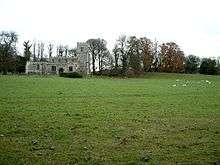Henry Harpur-Crewe
Henry Harpur-Crewe (1828–1883) was an English clergyman and naturalist. He was rector of Breadsall and then Drayton Beauchamp from 1860 until his death.

Henry Harpur-Crewe | |
|---|---|
| Born | 30 September 1828 |
| Died | 7 September 1883 |
| Nationality | British |
| Known for | Naturalist |
| Title | Reverend |
Biography
Henry Robert Harpur-Crewe was the nephew of Sir George Crewe bt. of Calke. He obtained a BA degree from Canterbury in 1851.[1] In 1857 he was the rector of Breadsall in Derbyshire, a small village which also included the naturalists Joseph Whittaker and Francis Darwin.[2]
He was interested in natural history from an early age, contributing observations to The Zoologist. His main interest was in entomology, particularly pug moths (Eupithecia). He was also a good botanist and a keen horticulturist (especially crocuses).[1]
One of his partners in botany was Joseph Whittaker of Breadsall and Morley who had practised botany in South Australia. In 1846 Harpur-Crewe and Whittaker reported on the earlier local extinction from Derbyshire of the lady's slipper orchid Cypripedium calceolus.[3] Whittaker's plant collecting activities began to decline around 1863 at about the time Crewe moved away to take up the position of rector in the parish of Drayton Beauchamp in Buckinghamshire. In 1864 they cooperated in the production of a manuscript list of the principal flowering plants and ferns of Derbyshire.[4] His productive partnership with Crewe lasted for at least eighteen years.
In 1877 Harpur-Crewe reported on a visit he made to Tresco in the Scilly Isles where he commented on the insects which was where "all the plants of Australia, the Cape, New Zealand, &c., flourish with almost native luxuriance.[5]
Legacy
Harpur-Crewe's plant collection are in the Natural History Museum whilst his letters are at Kew Gardens.[1] The Wisbech and Fenland Museum also has a small collection of Crewe's plants.[6] A miniature yellow double leafed wallflower Erysimum cheiri was rediscovered by Harpur-Crewe and is now named "Harpur Crewe".[7]
References
- Dictionary of British and Irish Botanists and Horticulturists: Including Plant Collectors, Flower Painter and Garden Designers
- White's 1857 Directory of Derbyshire (PDF). 1857. pp. 179–180. Archived from the original (PDF) on 16 July 2011. Retrieved 2 December 2010.
- "Cypripedium calceolus". The Flora of Derbyshire. Derby City Council. Archived from the original on 15 June 2011. Retrieved 30 November 2010.
- Linton, W. R. (1903). Flora of Derbyshire, London
- Harpur-Crewe, Robert (31 October 1877). "Entomology at Tresco and the Scilly Isles". The Entomologist. X.
- Nelson (2003). "Wisbech and Fenland Museum herbarium (WBCH): a history with a list of collectors" (PDF). Watsonia. 24: 489–494. Archived from the original (PDF) on 26 July 2011.
- Cornett, Peggy (January 2000). "In the Company of Gardeners: The Flower Diaries of Jefferson, Skipwith, and Faris". Twinleaf Journal. Retrieved 2 December 2010.
- IPNI. Crewe.